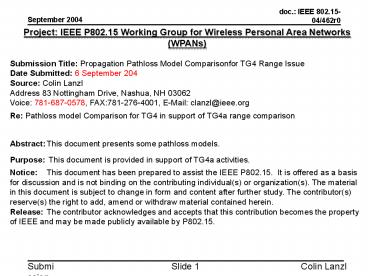Pathloss propagation model comparison - PowerPoint PPT Presentation
Title:
Pathloss propagation model comparison
Description:
Submission Title: Propagation Pathloss Model Comparisonfor TG4 Range Issue Date Submitted: 6 September 204 Source: Colin Lanzl Address 83 Nottingham Drive, Nashua, NH ... – PowerPoint PPT presentation
Number of Views:50
Avg rating:3.0/5.0
Title: Pathloss propagation model comparison
1
Project IEEE P802.15 Working Group for Wireless
Personal Area Networks (WPANs) Submission Title
Propagation Pathloss Model Comparisonfor TG4
Range Issue Date Submitted 6 September
204 Source Colin Lanzl Address 83 Nottingham
Drive, Nashua, NH 03062 Voice 781-687-0578,
FAX781-276-4001, E-Mail clanzl_at_ieee.org Re
Pathloss model Comparison for TG4 in support of
TG4a range comparison Abstract This document
presents some pathloss models. Purpose This
document is provided in support of TG4a
activities. Notice This document has been
prepared to assist the IEEE P802.15. It is
offered as a basis for discussion and is not
binding on the contributing individual(s) or
organization(s). The material in this document is
subject to change in form and content after
further study. The contributor(s) reserve(s) the
right to add, amend or withdraw material
contained herein. Release The contributor
acknowledges and accepts that this contribution
becomes the property of IEEE and may be made
publicly available by P802.15.
2
Two-breakpoint Model
- PL(d ) -10logc/(4pdfm)2 1-exp(-(dt1
/d)g-2)1-exp(-(dt2/d)?2- ?1, - Where
- PL pathloss, dB
- d distance between transmitter and receiver
- fm geometric mean of transmitted frequency
band - g1 propagation constant after first
breakpoint - g2 propagation constant after second
breakpoint - c velocity of propagation
- dt1 first breakpoint distance from
transmitter - dt2 second breakpoint distance from
transmitter
3
Loss-per-meter Model
- PL(d ) -10logc/(4pdfm)2 ?d,
- Where
- PL pathloss, dB
- d distance between transmitter and receiver
- fm geometric mean of transmitted frequency
band - ? loss-per-meter parameter
- c velocity of propagation
4
Comparison































